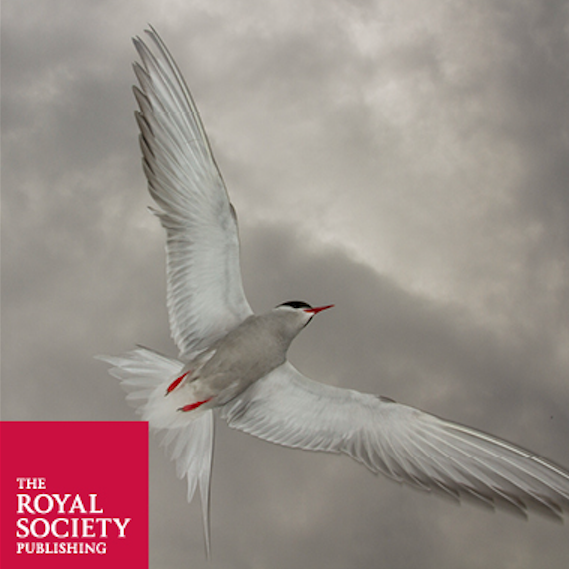Moving in a moving medium: new perspectives on flight
A special issue of the Philosophical Transactions of the Royal Society B.
Edited by
Steven J. Portugal and Emily L.C. Shepard.
Cycling into even a small breeze can be surprisingly hard work. The stronger the wind gets, the harder you have to work against it. If your daily commute involved cycling against the wind, it wouldn’t be surprising if you ended up picking routes that were sheltered from the wind.
This is just one of the realities that flying animals face all the time – whether it is windy, gusty, whether the air is rising or sinking, the air is hardly ever still.
Last year, Steve Portugal and I edited a special issue of Philosophical Transactions of the Royal Society B, examining how flying animals respond to the challenges – and opportunities – that come with moving in a medium that is, itself, on the move.

Our own paper (Shepard, Williamson & Windsor) shows that gulls alter their flight paths to take advantage of updraughts associated with buildings. The issue of gulls in cities is an interesting one, as populations of Herring Gulls and Lesser Black-backed Gulls are declining in many rural areas but expanding in urban locations. Buildings provide ample updraughts under a range of conditions, which might be one of the factors making urban areas profitable for soaring birds. However, urban airflows are very complex and we also show that that gulls appear to modify their fine-scale trajectories in a manner that affords them greater flight control in the face of gusts. So exploiting airflows in urban areas is not without its risks.
Insects are very slow fliers and therefore have the least ability to work against air currents. But how do they know which way a particular air current is flowing? It is not at all easy to tell, given that insects can fly so high above the ground they can’t see which way it is moving beneath them and the air itself is invisible. Nonetheless, we know insects can pick out airflows that can help take them to their desired destination on migration. Reynolds et al suggest that insects experience jerks from turbulent air currents, which are minimised when insects fly downwind – so the smoother the ride, the more likely they are flying with the flow, rather than against it. This, combined with an internal compass, is what they need to migrate between their breeding and feeding areas.

Tools from radar to animal-attached loggers have been crucial in helping us understand how animals respond to the movements of the air – as a range of articles in the issue show. But as far as we have come, many more questions lie ahead. We know very little about how animals respond to fine-scale turbulence, for example, although some exciting experimental work is underway (as discussed by Ortega-Jimenez et al in this issue). As we understand more about the way individuals respond to airflows (whether the responses are biomechanical, physiological or behavioural), this will help ecologists understand when and how airflows affect population processes.
References
Åkesson, S., Bianco, G. & Hedenström, A. 2016. Research article: Negotiating an ecological barrier: crossing the Sahara in relation to winds by common swifts. Phil. Trans. R. Soc. B 371 20150397; DOI: 10.1098/rstb.2015.0397 VIEW
Harel, R., Duriez, O., Spiegel, O., Fluor, J., Horvitz, N., Getz, W.M., Bouten, W., Sarrazin, F., Hatzofe, O. & Nathan, R. 2016. Research article: Decision-making by a soaring bird: time, energy and risk considerations at different spatio-temporal scales. Phil. Trans. R. Soc. B 371 20150397; DOI: 10.1098/rstb.2015.0397. VIEW
Hedenström, A. & Åkesson, S. 2016. Research article: Ecology of tern flight in relation to wind, topography and aerodynamic theory. Phil. Trans. R. Soc. B 371 20150396; DOI: 10.1098/rstb.2015.0396. VIEW
Reynolds, A.M., Reynolds, D.R., Sane, S.P., Hu, G. & Chapman, J.W. 2016 Review article: Orientation in high-flying migrant insects in relation to flows: mechanisms and strategies. Phil. Trans. R. Soc. B 371 20150392; DOI: 10.1098/rstb.2015.0392. VIEW
Shepard, E.L.C., Williamson, C. & Windsor, S.P. 2016. Research article: Fine-scale flight strategies of gulls in urban airflows indicate risk and reward in city living. Phil. Trans. R. Soc. B 371 20150394; DOI: 10.1098/rstb.2015.0394. VIEW
Taylor, G.K., Reynolds, K.V. & Thomas, A.L.R. 2016. Research article: Soaring energetics and glide performance in a moving atmosphere. Phil. Trans. R. Soc. B 371 20150398; DOI: 10.1098/rstb.2015.0398. VIEW
Image credits
From top:
Arctic Tern, Farne Islands, UK, © Harry Read www.harryreadphotography.co.uk
Common Swift | pau.artigas | CC-BY-SA-2.0 | via Wikimedia Commons
Griffon Vulture | MinoZig | CC-Zero | via Wikimedia Commons
The BOU has received payment from the Royal Society to advertise ‘Moving in a moving medium: new perspectives on flight’ a special issue of the Philosophical Transactions of the Royal Society B in their 10 January 2017 e-newsletter (see here). This blog is linked to that special issue of Philosophical Transactions of the Royal Society B and the related Twitter event #flight on 10 January 2017 run by the BOU via their account @IBIS_journal. No payment was received for this blog post or Twitter event, and no payment was made by the BOU to the author of this blog or any other party in relation to this blog post or Twitter event.
If you want to write about your research in #theBOUblog, then please see here.





